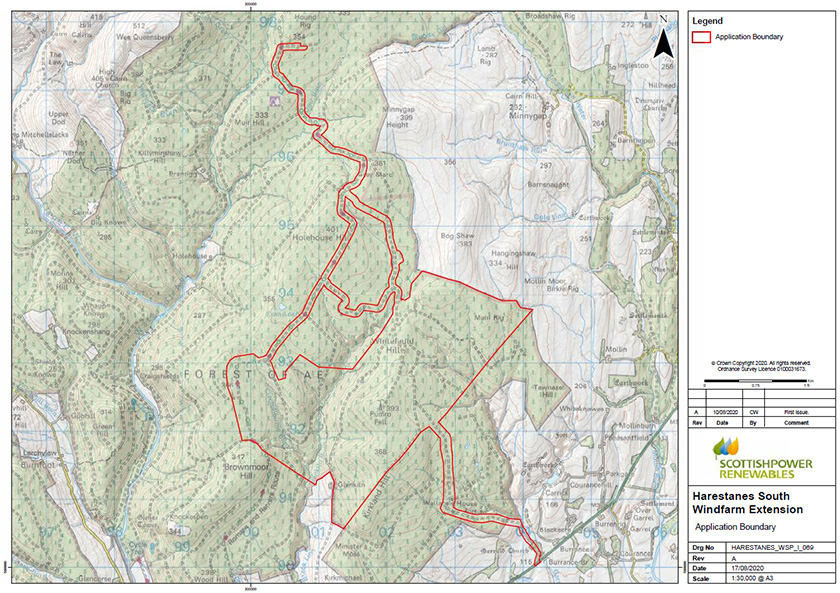The proposed Site boundary is shown below:

View a larger version of the map above
The proposed development layout is shown below:

View a larger version of the map above
Key project details
 | Eight wind turbines with a maximum height to blade tip of 200 metres |
 | Generating capacity of around 45 megawatts (MW) |
 | Generating enough electricity to supply electricity for the equivalent of around 28,000* UK homes. |
* Based on the following calculation: 45MW (installed capacity) x 0.266 “onshore wind” average load factor (Digest of UK Energy Statistics) x 8,760 hours (hours per year)/3,729 KWh (average domestic annual consumption) = 28,119 homes powered equivalent
Site design considerations
The site at Harestanes South has been chosen for a number of reasons: it features high wind speeds, benefits from existing grid connection and site access from the operational Harestanes Windfarm and from an existing commercial forestry track network. The site is also within a low population density area and is in close proximity to an established road network.
We presented our initial design layout in May 2020 to the public and consultees. Since then, and in response to feedback that we have received, the following amendments have been made to the layout:
- The number of turbines has been reduced from 15 to 8 to minimise landscape and visual effects from a number of sensitive locations.
- Turbines have been removed from the western region of the site where they were in proximity to the 7Stanes Trail Centre and the group of properties at Ae, reducing potential impacts on recreation and from noise.
- The position of turbines and infrastructure has been refined to minimise impacts on peat, ecological receptors and cultural heritage assets.
- The main construction compound and an area of hardstanding both forming part of the existing infrastructure of the operational Harestanes Windfarm will be utilised during construction thus reducing the footprint of the proposed Development.
- Turbine positions considered in relation to views against Queensberry Hill, to provide as much separation as possible.
- Turbines now located predominantly within the interior of the site (west of Pumro Hill and associated ridgeline, and north of hills in relation to Ae Village) to reduce the impact of views from the east, south east and south.
Development and Environmental Impact Assessment (EIA) process
Feasibility Study: 2019 | A feasibility study was undertaken prior to scoping to understand the constraints of the site, and determine whether it was a viable option for development. |
Scoping: April 2020 | Scoping is the name given to the initial consultation which we undertook with stakeholders to identify key issues for us to consider when designing and environmentally assessing the proposed windfarm and provide information on the proposed assessments to be undertaken in the Environmental Impact Assessment. This was submitted to Scottish Government in April 2020. |
Environmental Impact Assessment: Ongoing | An Environmental Impact Assessment is a formal part of the windfarm planning process, which involves undertaking environmental surveys of the proposed site by independent specialists to quantify and identify any significant environmental effects the windfarm may have; and to identify appropriate measures to eliminate, avoid, reduce or mitigate any potentially significant adverse effects. The Environmental Impact Assessment for Harestanes South Windfarm Extension will assess the potential for effects from the following environmental topics: Landscape and visual Noise Ecology Ornithology Archaeology and cultural Heritage Access, traffic and transport Ecology and biodiversity Hydrology, hydrogeology, geology and soils Other issues including Forestry and Land Use, Aviation and Radar, Telecommunications, Climate and Carbon Balance Cumulative effects
|
Pre-application Consultation | To ensure that we continue to engage with all interested parties during the current COVID-19 situation, we are conducting this public consultation to present the work we have done and our proposed windfarm design in order to receive your feedback. It provides the latest iteration of the design. |
Environmental Impact Assessment Report | The findings of the Environmental Impact Assessment will be documented in an Environmental Impact Assessment Report. The Environmental Impact Assessment Report will be issued to the Scottish Government as part of our application for consent. When this document is finalised, copies will be available for viewing at locations in the vicinity of the proposed windfarm. |
Submission of Application for Consent: Winter 2020 | We will submit an application to the Scottish Ministers for determination under Section 36 of the Electricity Act 1989. |
Evaluation and Determination of Application | The application will be administered by the Scottish Government Energy Consents Unit (ECU) on behalf of Scottish Ministers. There will be an opportunity at this stage for you to make formal representations on the application to the ECU. These will then be taken into account by Scottish Ministers when determining whether or not to grant consent for the proposed Development. Timescales for determination are variable and depedent upon case specfic issues but typically take between 12 to 15 months |
Go back to the main pageGo to the next page